

 Cover photo: UTMB Campus aerial view from east to west, overlooking the Port of Galveston
UTMB’s Open Gates Building - the former George Sealy Mansion, located at 2419 Sealy Avenue, Galveston, TX (Galveston’s old world charm)
Cover photo: UTMB Campus aerial view from east to west, overlooking the Port of Galveston
UTMB’s Open Gates Building - the former George Sealy Mansion, located at 2419 Sealy Avenue, Galveston, TX (Galveston’s old world charm)



 Cover photo: UTMB Campus aerial view from east to west, overlooking the Port of Galveston
UTMB’s Open Gates Building - the former George Sealy Mansion, located at 2419 Sealy Avenue, Galveston, TX (Galveston’s old world charm)
Cover photo: UTMB Campus aerial view from east to west, overlooking the Port of Galveston
UTMB’s Open Gates Building - the former George Sealy Mansion, located at 2419 Sealy Avenue, Galveston, TX (Galveston’s old world charm)



Welcome to the 3rd annual UTMB Environmental Health and Safety (EHS) report detailing fiscal year 2021. Our annual report is an effort to communicate the most relevant parts of EHS and showcase our programs, services, and collaborations throughout UTMB Health.
This year, we are spotlighting our EHS staff who are recognized as leaders in emergency response. Their efforts and quick response kept staff safe and allowed the campus to return to its productive work in a short time. Our staff have worked vigorously and without hesitation throughout the year to respond and
remediate spills of hazardous materials, potable water supply issues, odor and smoke calls, and other safety incidents all with the express goal of keeping our campus, patients, staff, and community safe.
EHS has updated and implemented our safety programs supporting an environmentally responsible campus and we encourage all at UTMB to embrace the safety culture. Our programs are class leaders in safety and protecting all our campuses, clinics, and work locations. We invite you to join our culture of safety that continues to make UTMB a great place to work.
We hope you find this information interesting and useful.
JACK TARPLEY AVP, EHS Jack
Environmental Health and Safety is a resource to help our customers achieve their missions in the safest way possible.
It is our vision to become a recognized national leader and innovator in campus environmental health and safety providing world class services.

The mission of Environmental Health and Safety is to work with our customers to provide a workplace free of recognized hazards in support of the UTMB mission to improve health for the people of Texas and around the world.
Integrity: Saying what we are going to do, and doing what we say.
Accountability: Holding ourselves and each other accountable for our responsibilities and achieving our goals.
Commitment: To protect the health and safety of our patients, employees, the public, and the environment.
Collaboration: Developing strategic partnerships that foster cooperation and collaboration.
Personifying excellence: Providing the highest level of expertise, competence, and professionalism in our staff.
Quality: Going beyond regulatory “compliance” and aiming for best-in-class.

Environmental Stewardship: Taking the lead to protect the environment and preserve our natural resources.

Environmental Health and Safety is a part of Business Operations & Facilities (BOF). Units under this group provide institutional support through many business and facilitiesrelated processes. In addition to EHS, BOF includes the areas of Auxiliary Enterprises, Design & Construction, Portfolio Management, Property Services, and Utilities.






































BEN G. RAIMER, MD, MA, FAAP, PRESIDENT
STEVEN LEBLANC, PE, MBA, CHFM, VICE PRESIDENT
JACK TARPLEY, MS, CFI, CHMM, ASSOCIATE VICE PRESIDENT CHARLES CARLISLE, MS, CIH, CSP, CHMM, PROGRAM DIRECTOR DE'ANNE MEEH, MS, REM, CHMM, PROGRAM DIRECTOR WILLIAM PATE, DRPH, MBA, LMP, CHP, CIH, CSP, CPP®, CHFM, CHMM, PROGRAM DIRECTOR
A safe work environment is truly achieved when the organization makes it a core value and integrates safety into the way they work.
The University of Texas Medical Branch
Business Operations & Facilities Environmental Health and Safety
Humberto Espino
Sr. Administrative Mgr.
Susie Del Bosque
Sr Admin Support Associate

Victoria Castillo Business Coordinator
Fire & Life Safety Program Director
Jennifer Riveira Todd Perry Dr. Mario Soares Dr. Timothy Read EHS Consultants
Billy Martin EOC Compliance Mgr.
Geraldine Giannotti EOC Safety Specialist
Michael Puccetti Brandon Metting Walter Mays Safety Specialists
Corey Wilhite Clint Straitwell Safety Technicians
Environmental Protection Program Director
Eddie Stanaland Meagan Thibodaux EHS Consultants
Sergio Garcia Dean Leathers Jeremy Wilke Sr. Safety Specialists
Jordan Sweet Michael Scott Safety Specialists
Michael Shulke Sr. Safety Technician
Radiation Safety & Occupational Safety Program Director























Jim Stone David Stephenson EHS Consultants
Eduardo Reyna Construction Safety Mgr.
Morgan Gerami
Sr. Occ. Safety Specialist
Darla Goodman Swan Miller Radiation Safety Specialists
Kendle Latiolais Adam Jennings Occ. Safety Specialists
Sharon Walters Sr. Business Coordinator
Lyndin Simpson Samantha Thompson Occ. Safety Technicians

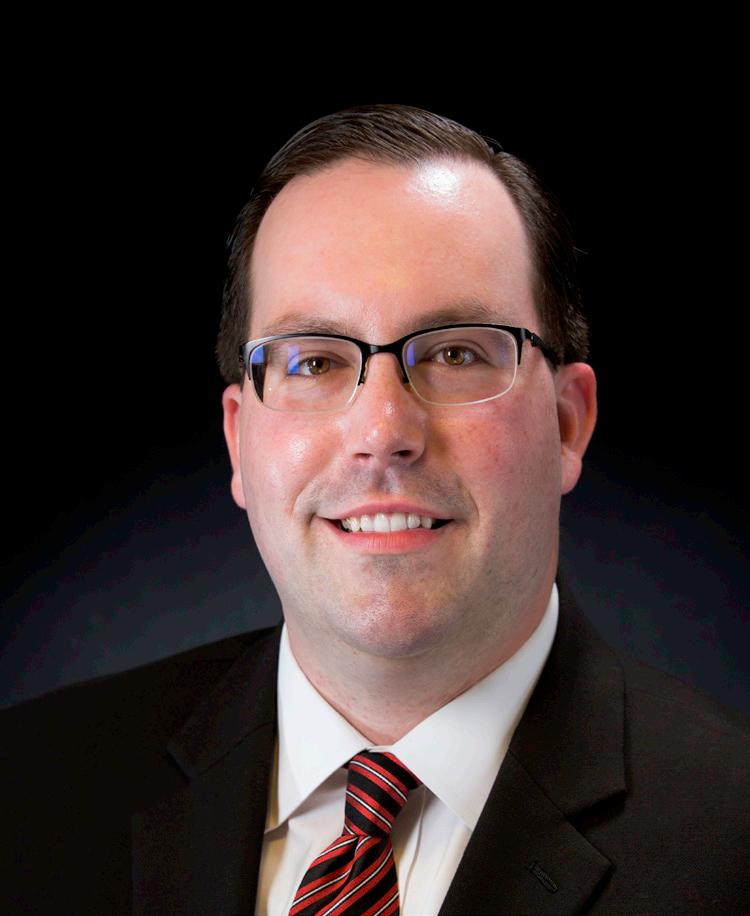

• Chemical Safety
• Fall Protection
• Hearing Conservation
• Aerial Lift and Crane Safety
• Respiratory Protection
• Construction Safety
• Regulatory Compliance and Support
• Hazardous Waste Management
• Water Quality (Storm water and Wastewater)
• Pollution and Spill Prevention
• Air Emission Management
• Emergency Planning & Community Right to Know
• Medical Waste Management
• Compliance Training
• Fire/Life Safety Systems Design, Installation, Testing, and Repair
• Facility Design/Compliance Reviews
• Fire Drills and Institutional Response
• Life Safety/Joint Commission Compliance
• Fire Extinguisher Inspections
• Environment of Care compliance and committee support
• Life safety building inspections
• Process safety management Interim Life Safety Measures, Hot Work Permitting, and Above Ceiling Work Permitting
• Radioactive Materials Permitting and Licensing
• X-ray and Laser Registration
• Laboratory Evaluations
• EHS supported public health to ensure safe mass COVID-19 vaccination events in Galveston & Brazoria counties
• Developed and implemented COVID-19 PPE waste acceptance and packaging requirements for the triage tent sites
• Provided guidance on how to best manage waste generated during the care of patients with COVID-19
• Partnering with other BOF divisions to ensure EPA & TCEQ Air Permit regualtion & compliance are met
• Facility operations are monitored 7 days/week
HANDS ON TRAINING ON FIRE SYSTEMS & FIRE RESPONSE
• Wide variety of fire training across all departments
• EHS also conducts over 100 other training per year
• EHS conducts pre-existing condition inspections
• Single database warehouse of all TJC documents required for JC survey
• Integrated automatic emergency notifications provide a variety of campus-wide fire & security emergencies
• EHS evaluated several different types of alternative N95 repirators and gloves to ensure adequate availability of PPE
EHS works closely with other campus departments such as Facilities Risk Management, Design & Construction, Property Services, Healthcare Quality & Safety, Infection Control & Healthcare Epidemiology, Portfolio Management, Utilities, UT System Police, and the University’s schools.


EHS serves as a liaison with regulatory and compliance agencies such as: The Joint Commission, EPA, DEA, U.S. DOT, TCEQ, Texas DSHS, FAA, Federal Select Agent Program, Texas State Fire Marshal’s Office, NIH Office of Science Policy, AAALAC, and local municipalities. EHS is charged with certain health and safety inspections and compliance for all applicable federal, state, and local regulations and other EHS requirements intended to protect safety, health, and the environment.

EHS serves the entire UTMB community. Our customers include patients, faculty, staff, students, campus visitors, and volunteers.
In FY21 EHS received 236 calls for emergency support ranging from fire alarm activations to hazardous material spills.
EHS provides support on UTMB campuses in ensuring healthy and safe operations, protecting students, faculty, staff, and visitors, and protection of the environment.
• Construction plan review
Serving on regulatory committees
Subject matter experts on health and safety issues to ensure safe design, construction and operation of UTMB facilities
Local Emergency Management
• City of Galveston
City of Angleton
City of Webster
City of League City
• Odor & Indoor Air Quality response
Hazardous materials shipments
Risk assessments
Accident investigations
Emergency incident response
Exposure monitoring
Respirator fit testing
Occupational Health & Medical Surveillance Program
• Environment of Care
Committee Support
TJC documentation
Survey support
Risk Assessments
• 24/7 incident response
• Food establishment inspections
Drinking water testing
Identification of slip/ trip/fall hazards

Spill cleanup
Facility Safety Audits
Fire System Repairs
• Update and maintain online safety courses
Instructor-led training
• Technical review for renovations
• Space evaluations
• Fume hood certifications
Lab Audits
Controlled substance disposal
Protocol & permit reviews for committees

Consulting on safe lab practices
Equipment cleanup/ monitoring
Lab setup/closeouts
• Storm Water Programs
Title V Permit Management
Chemical & Biological spill cleanup
Hazardous Waste Disposal
Potable Water System Permit




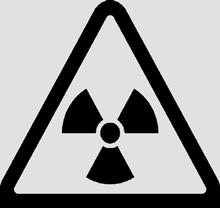




Located along the Texas Gulf Coast, UTMB is accustomed and prepared for relatively mild winters. However, in February 2021, the entire State of Texas was challenged with an extraordinary winter weather event that has been unofficially referred to as “Winter Storm Uri”. Over several days, UTMB faced numeous challenges related to the extreme cold and the impacts they had to our buildings and utility systems.
Based upon our location, outdoor fire suppression systems at UTMB have typically not been designed for extended periods of freezing temperatures. Because the temperature stayed as cold as it did for an extended period, water inside of the fire sprinkler pipes and other exterior water pipes began to burst. EHS staff responded quickly to these broken sprinkler pipes, taking steps to repair them and return fire protection to our buildings as quickly as possible.
As with others throughout the state, several UTMB facilities ended up losing electrical power because of rolling blackouts that had been mandated by the Electric Reliability Council of Texas (ERCOT). Although direct impact to our hospital facilities due to power loss was minimal, power losses combined with water leaks from burst water mains across the region led to serious reduction in potable water pressure. This loss of pressure could have had direct impact to patient and employee safety by making it impossible to wash hands, sterilize equipment, or even flush toilets. EHS staff, collaborating with Utilities and Property Services, worked tirelessly in below-freezing temperatures to identify and open water valves leading into our facilities to increase water pressure.
Previous plans to tap into the City of Galveston water tower were also activated successfully, helping us to avoid a total loss of water pressure. EHS also actively monitored chlorine residual levels to ensure that the water that was entering our facilities remained safe for consumption.

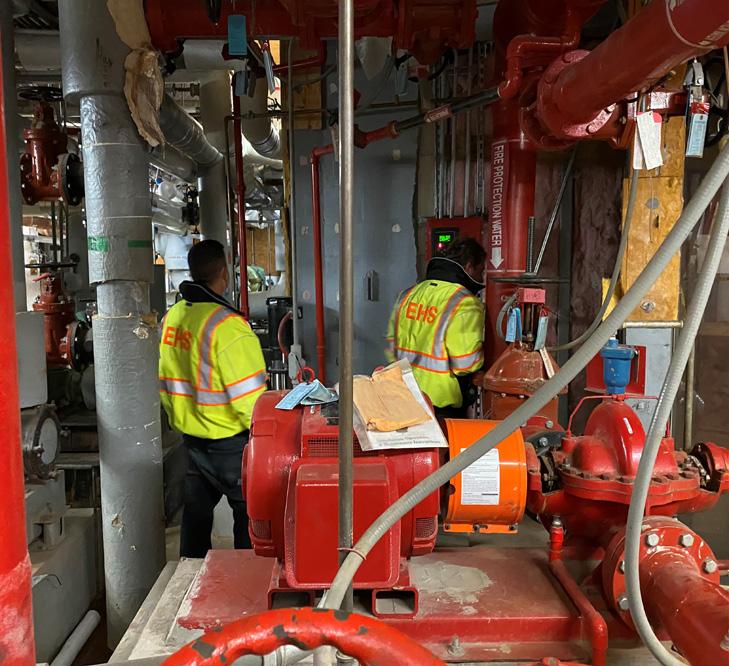
Another impact from the reduction in water pressure to our hospitals was to our inpatient dialysis unit. Dialysis equipment requires a certain minimum water pressure to function, and the water pressure in our buildings did not meet these minimums. With several patients in urgent need of dialysis, a collaborative effort was made to develop a stopgap measure to allow for emergency dialysis to be performed. Clinical Equipment Services, dialysis clinicians, and EHS worked together to create a temporary dialysis water source using a 55-gallon drum of potable water and an external water pump to increase water pressure to an acceptable level. Although water pressure levels in the building increased before this had to be implemented, UTMB now has an off the shelf method to provide emergency dialysis if we face future situations resulting in loss of water pressure.


The UTMB Environmental Protection Management (EPM) program is a collection of programs that are governed by environmental laws, regulations, and permits; facility operations; and technical services for hazardous materials and waste disposal. This includes integration of environmental compliance into business objectives to ensure the programs achieve ownership, collaboration, and support necessary for compliance.


The UTMB Angleton Danbury Campus has many supported environmental programs ranging from the Clean Water Act, to the Emergency Planning and Community Right to Know Act, and the Resource Conservation and Recovery Act.

The Angleton Danbury Campus is a Very Small Quantity Generator. Hazardous waste is picked up as needed on the campus, as it generates less than any other campus. The campus has a Spill Prevention Control and Countermeasure program under the Clean Water Act for petroleum storage and spill prevention. Angleton Danbury also has a Permit By Rule program for air compliance. Tier II reporting is required on an annual basis as required by EPCRA.
UTMB League City Campus is the second largest producer of hazardous waste within the four campuses. This campus is a Small Quantity generator and requires hazardous waste collection twice a week. Bulking is performed on site at the Chemical Accumulation Facility. As a unique service to League City Campus, radioactive wipes are also performed once a week.
Due to the hazardous materials stored on site, a Tier II is required annually. The League City Campus also has Clean Air Act regulations that fall under Permit By Rules. A certified SPCC program is in place on the campus due to having more than 10,000 gallons of petroleum product on site.
A unique program the League City Campus has is the Municipal Separate Storm Sewer System. The campus has a Small Phase II Storm Water Program that oversees construction projects on campus.
The newest addition to the regional hospital system is the UTMB Clear Lake Campus. Since opening, the Clear Lake Campus has become a small quantity generator of hazardous waste and has recently been engineered compliant to bulk in the Chemical Accumulation Facility on site. In addition to hazardous waste management, a Spill
Prevention Control and Countermeasure program is managed with monthly inspections of all areas storing petroleum for spill prevention.
Under EPCRA, Clear Lake Campus is required to submit a Tier II report of hazardous materials stored on site. Multiple air Permit By Rules are in place for air compliance.
The Galveston Campus is the largest of all four campuses and houses the most environmental programs. The Galveston Campus supports many CWA programs such as Spill Prevention Control and Countermeasure for protection of oil spills in the bay, a

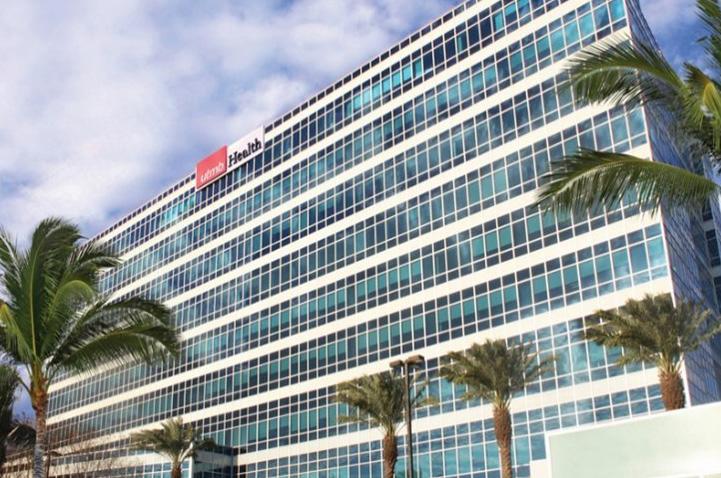

robust Phase II Small Municipal Separate Storm Sewer System for storm water protection, and daily and monthly monitoring for the Public Water System.
The Galveston Campus is a Large Quantity Generator of hazardous waste, due to this, campus has implemented a Pollution Prevention program to reduce hazardous waste. Galveston Campus not only manages hazardous waste, but medical waste as well. The Galveston Campus houses a medical waste incinerator and all applicable compliance regulations including a Title V Clean Air Act Permit. The Galveston Campus is also a MS4 for storm water and construction sites are managed internally for environmental compliance. Tier II inventories are submitted for all chemicals at reporting thresholds.
The Fire and Life Safety Program has a system-wide mission to provide employees, patients, and visitors with a safe physical environment. To do so, we survey the environment, identify potential problems, champion solutions and track them to resolution. In addition, we achieve this goal through routine inspection and testing of Life Safety features of our facilities to ensure code comliance and that they will function properly in times of an emergency. The Fire and Life Safety group also serves as the liaison to local fire officials, the Joint Commission Life Safety surveyor, and is responsible for fire emergency planning. We help develop departmental plans as well as building-wide and institutional responses to emergencies.
• Provided significant resources into the John Sealy Modernization project and successfully completed the A&B phase of the project in conjunction with design and construction
• Completed life safety drawings updates and assessments for all UTMB healthcare facilities
• Performed multiple modifications and repairs to existing fire and life safety systems to ensure all UTMB facilities stay up-to-date with the latest technology available in the fire safety industry
• Implemented and expanded UTMB’s mass notification abilities and integration with Everbridge enterprise communication software to provide process improvement across departments for emergency notification.
• Finalized and implemented new ATG enterprise permitting software, to be utilized to request and track preconstruction risk assessments, utility shutdowns, interim life safety measures, hot work activity, and above ceiling work
• Implemented new SharePoint-based document management library for Joint Commission compliance
• Quickly and efficiently responded and recovered UTMB operations from the winter freeze to minimize system down time and maintain a safe environment for patients, visitors, staff, and students
• Continued maintenance of fire safety systems (fire extinguishers, sprinkler systems, fire alarm systems, etc.), ensuring that the safety of our visitors, patients, students, and staff are not compromised
• Replaced the aging fire pump and fire alarm system in the Ashbel Smith building “Old Red”
• Upgraded fire alarm system to voice and mass notification capabilities in University Eye Clinic building, Materials Management Warehouse building, and Ashbel Smith building
• Replaced aging fire pump and controller and re-fed electrical services in the Keiller building
• Implemented a new life safety building inspection program with improved Maximo integrations for tracking repairs
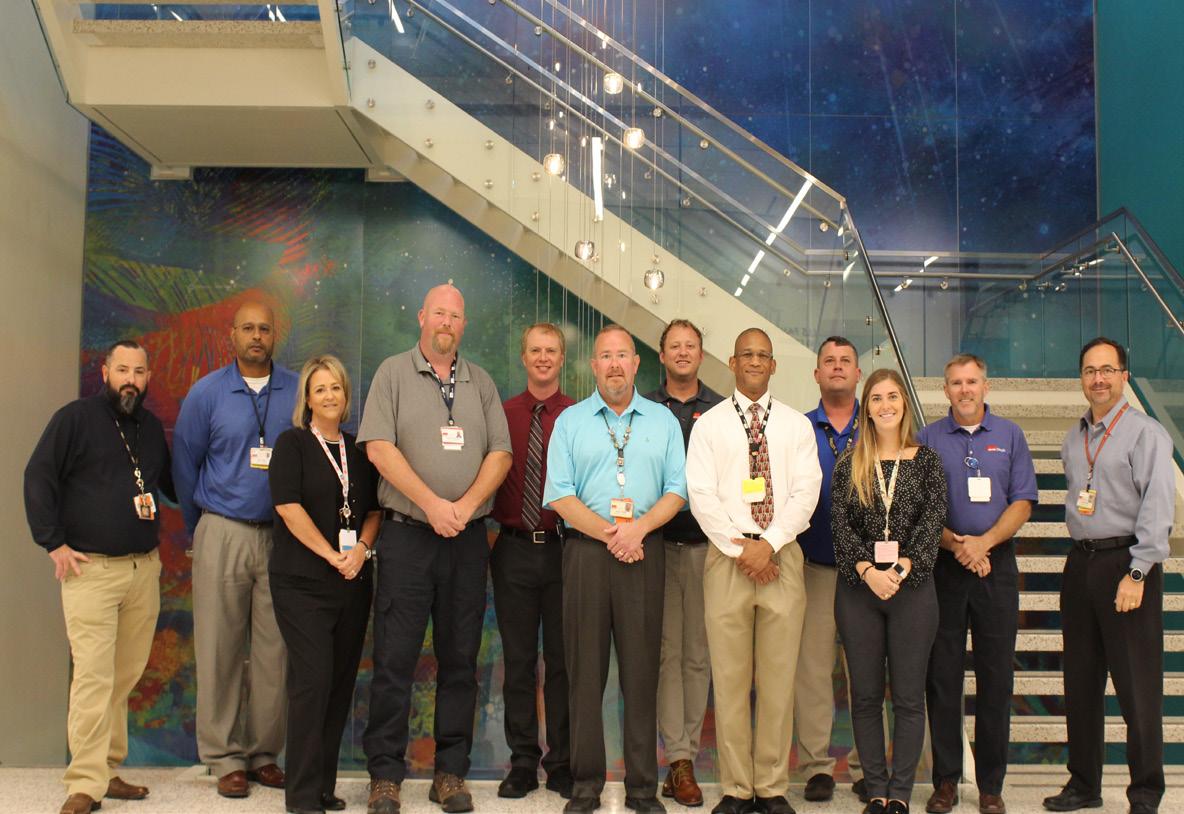
• Improved kitchen fire safety program and implemented engineering controls to maintain compliance with joint commission standards
• Fire and Life Safety is continuing to reduce costs of services on a per square foot basis, while the campus expands efforts to meet the needs of the community
• Multiple projects to replace and install new sprinkler systems in Levin Hall and Trauma Center
• The Joint Commission tri-annual survey
• Further improve upon and integrate systems for emergency, and mass-notification communications
• Replace fire alarm system in Clear Lake Campus Hospital
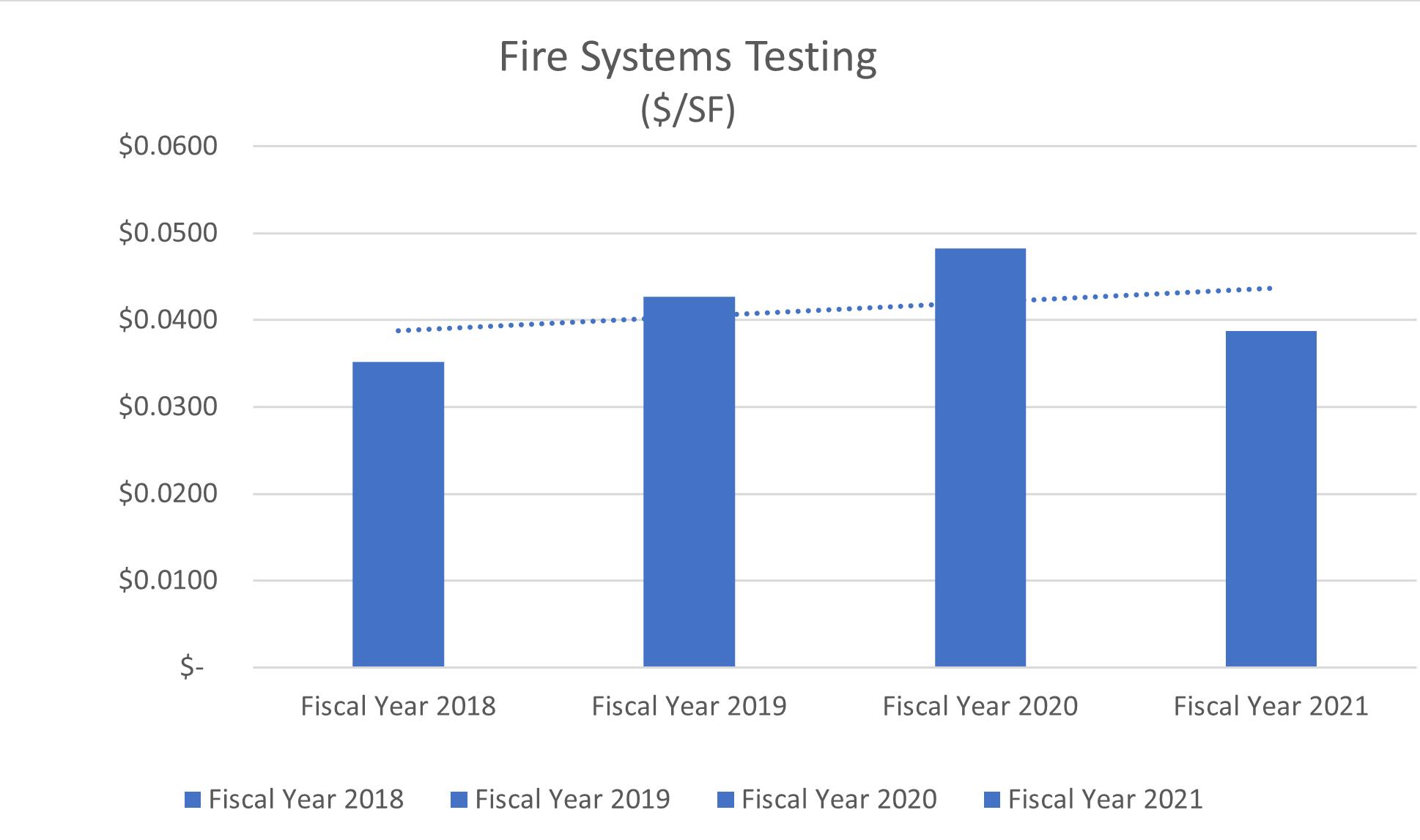
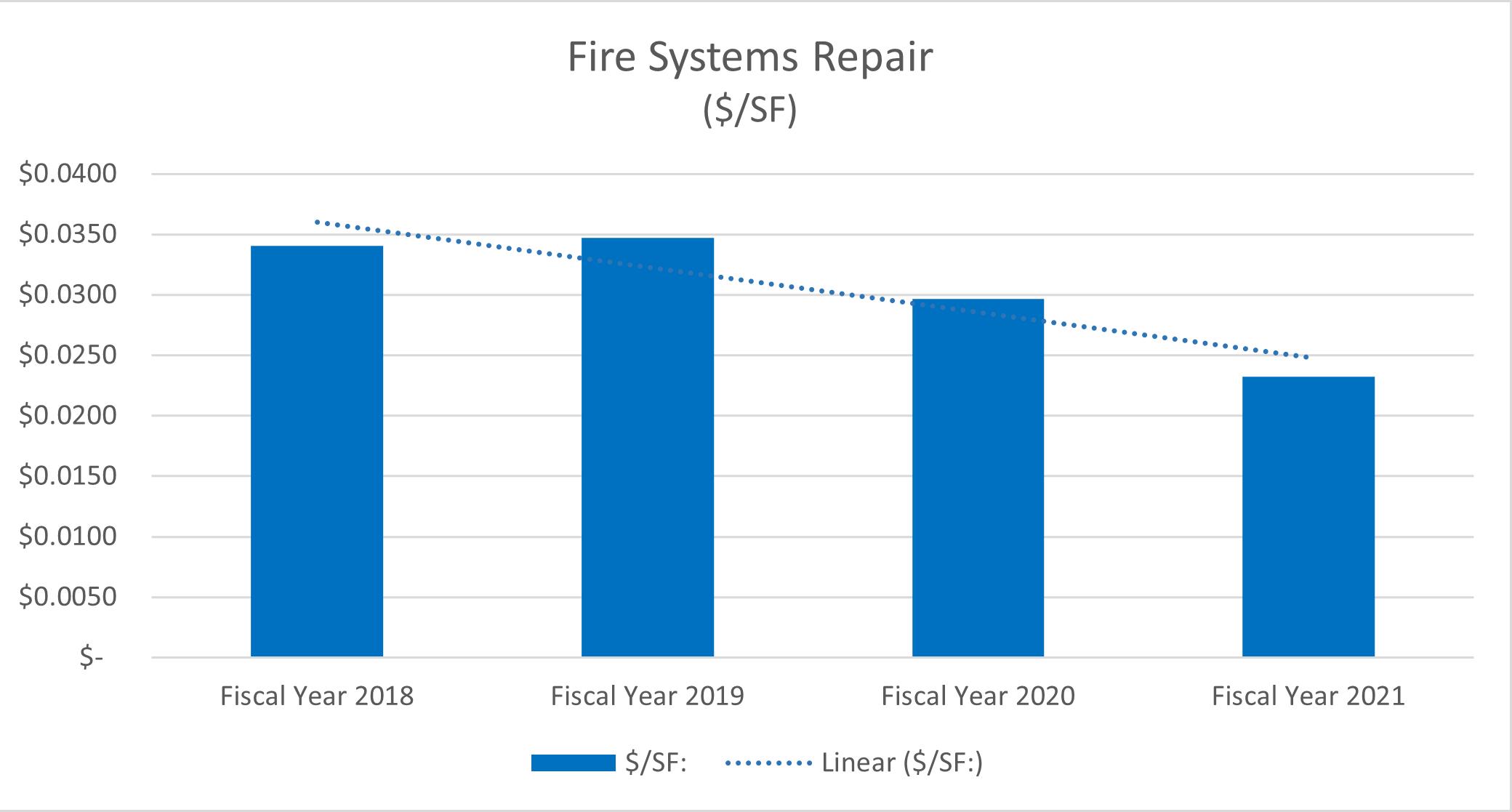
As part of the Fire and Life Safety mission, we provide employees, students, patients, and visitors with a safe physical environment to conduct business, study, delivery, and receive care. Our staff efficiently tests and inspects Life Safety features to ensure code compliance and that the Life Safety features function properly during an emergency.
As a part of our ongoing efforts to be good stewards of UTMB resources, EHS constantly strives to reduce costs through competitive bidding of services, close attention to work service, and efficiency and effective maintenance strategies. This has allowed us to do things like reduce the rate of repair costs while the institution has grown.
The Radiation & Occupational Safety Program (ROccS) works to ensure the safety of laboratory and healthcare workers. Our technical expertise covers a wide range of areas, including radiation safety, laboratory safety, food & potable water safety, and industrial & construction safety. Services offered include: sealed source leak tests, receipt & surveying research radioactive material packages, laboratory safety audits, calibration of survey equipment, food safety inspections and permitting, respirator fit tests, and providing training on a wide range of safety topics.
• Implementation of EHS Assistant to document formal follow-up responses from food safety inspections
• Successful implementation of new veterinary x-ray regulations requiring quarterly QA/QC and more frequent equipment performance evaluations
• Performed 10,304 respirator fit tests, in response to the COVID-19 pandemic
• Supported the construction and opening of the new Dave Bleakney building in Angleton, including shielding design and verification of relocated x-ray equipment
• Transitioned chemical fume hood certification program from Biosafety to include updating of procedures and documents
• Radioactive material inspections from the Texas Department of State Health Services for the Galveston Campus, Angleton Danbury Campus, and Clear Lake Campus all had no violations
• Roll-out of respirator fit testing program improvements including expanded fit-test hours and monthly fit test at regional hospital campuses to support increased accessibility of fit testing for health care workers
• Continue to support ongoing and expanded fit testing needs for health care and research staff at all campuses
• Updates to Texas regulations on the medical use of radioactive materials expected in early 2022
• Initiate laboratory safety audit program under oversight of ROccS to include new comprehensive laboratory audit checklist
• Upcoming triennial Joint Commission survey will require Radiation & Occupational Safety Program support
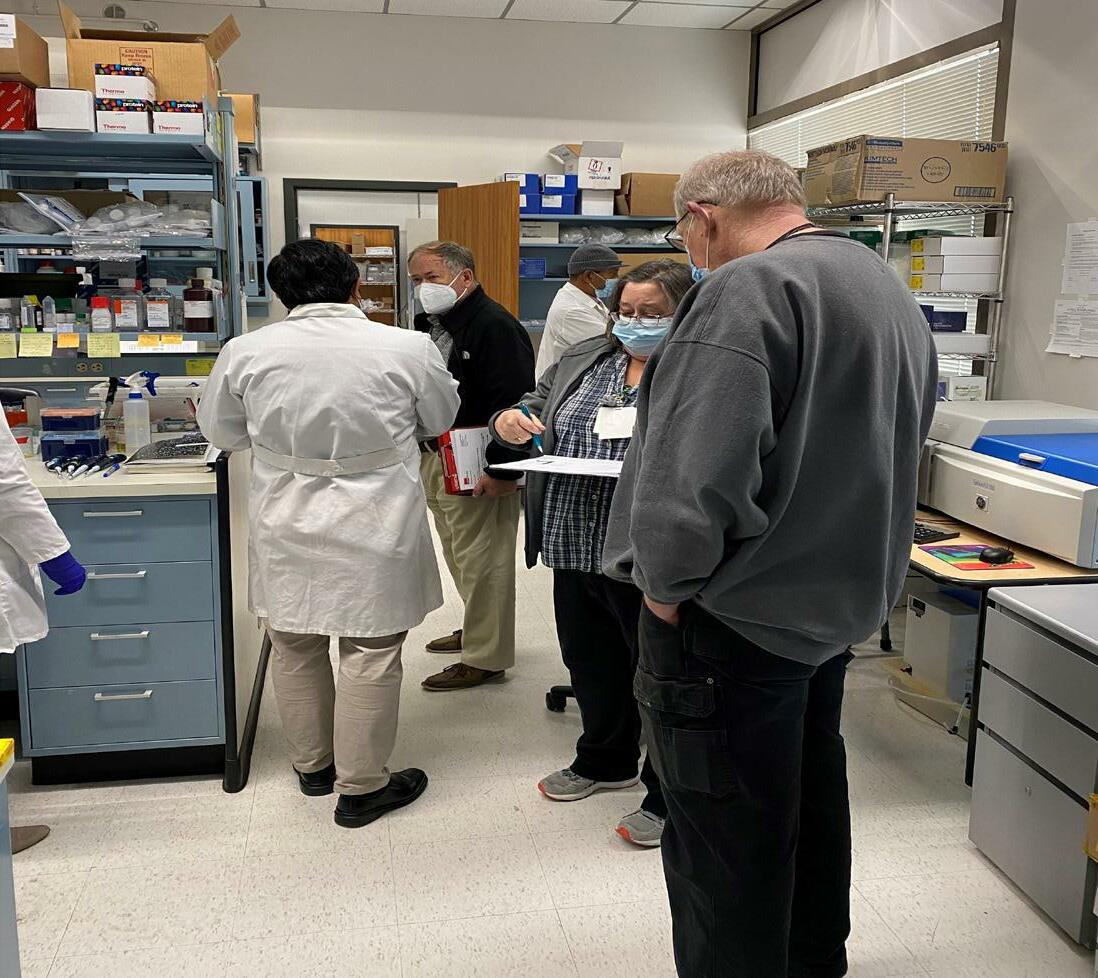 Darla Goodman, Radiation Safety Specialist, interacting with lab staff and Texas Department of State Health Services radioactive materials inspectors
Darla Goodman, Radiation Safety Specialist, interacting with lab staff and Texas Department of State Health Services radioactive materials inspectors
Fit testing performed by EHS con tinues to be in high demand due to the continuation of the COVID-19 pandemic. Fit testing performed in FY21 exceeded the number of fit tests performed in FY20. Earlier appointment times and adding ad ditional days for fit testing at each regional hospital campus help sup port health care worker fit testing needs.
Despite reductions in research use of radioactive material, the use of ionizing and non-ionizing radiation in health care continues to increase. The number of x-ray machines and dosimetry program participants has steadily increased over the years, primarily the result of UTMB health care expansion. Regulatory inspec tions remain steady, indicating con tinued need for EHS resources to support institutional compliance.

Number of X-Ray Machines
Inspections
of Dosimetry
Ensuring a high level of water qual ity continues to be a top priority to the health and safety of patients, employees, students, and visitors. As additional facilities are added, or in response to incidents, rou tine and emergency chlorine and coliform sampling is performed. Severe weather events such as Win ter Storm Uri resulted in additional samples being collected.
FY21 saw the release of several safe and effective COVID-19 vaccine options from different pharmaceutical companies. In an effort to support public health, UTMB participated in developing and providing mass vaccination events in Galveston County and Brazoria County.
Environmental Protection Management (EPM) provides technical services for protecting UTMB’s environmental liabilities with regulatory oversight for the Institutional medical waste processes. UTMB’s medical waste operations are permitted by the Texas Commission on Environmental Quality (TCEQ) municipal solid waste permitting and must meet regulations for medical waste transport, treatment, and disposal. EPM staff support the Environment of Care Committee with a significant role in monitoring waste trends and Institutional compliance with training for UTMB employees on proper management of pharmaceutical and medical wastes.
BOF Property Services and Utilities divisions partner with EPM to ensure the EPA and TCEQ Air Permit regulations and compliance are met during facility operations for the University’s sources of air pollution under the Clean Air Act. Facility operations and equipment controls are monitored 7 days/week for air pollutant emissions, restrictive operations times during the time of day, and recordable events when permit limitations are exceeded. BOF and EHS environmental compliance partnerships also include potable drinking water programs and medical waste operations.
EHS conducts a wide variety of fire training from hands-on system training to fire response training across all departments of UTMB. Outside of the annual fire response training EHS conducts over 100 additional trainings per year.
As a part of property acquisitions, EHS conducts pre-existing condition inspections to ensure the property being considered will be functional and compliant with Life Safety code.
The digital library, housed on SharePoint, is designed to be accessed throughout multiple departments and provide a single database warehouse of all documents required for a Joint Commission survey. The library follows TJCs format by Elements of Performance in the Environment of Care and Life Safety standards.
Through the campus fire alarm and Everbridge systems, EHS has successfully integrated automatic emergency notification ingestions to provide real time alerts for a variety of campus-wide fire and security emergencies including fire emergency, infant abduction, and active shooter alerts. This massive effort required close collaboration with UTPD, Nursing, and Clinical Services to develop and implement a functional and successful notification tool.
As a result of the CoVID-19 pandemic, the worlwide supply chain supporting health care has experienced significant challenges in ensuring materials vital for patient care are available. One area where health care organizations have struggled was in being able to procure personal protective equipment (PPE) necessary to keep workers safe.
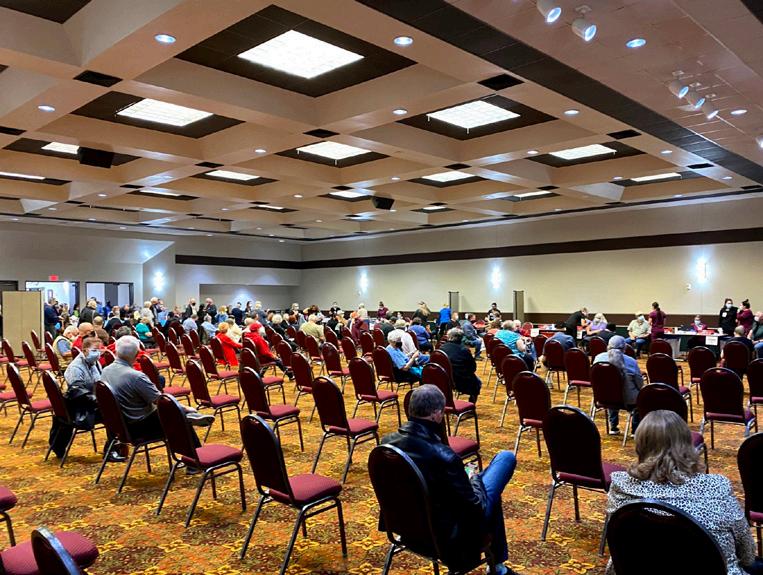

In Galveston County, UTMB collaborated with the Galveston County Health District to setup and run a mass vaccination site at Walter Hall Park in League City. Over the course of several weeks, members of the public were able to drive through and receive their COVID-19 vaccination. In Brazoria County, the UTMB Angleton Danbury Campus took the lead in setting up vaccination sites on their Campus, as well as on sites in the community such as the Lake Jackson Community Center. Environmental Health & Safety played a role in helping ensure safe mass vaccination events, evaluating proposed locations for events, evaluating and controlling hazards on-site, as well as helping to manage medical waste collection and disposal for Brazoria County locations.
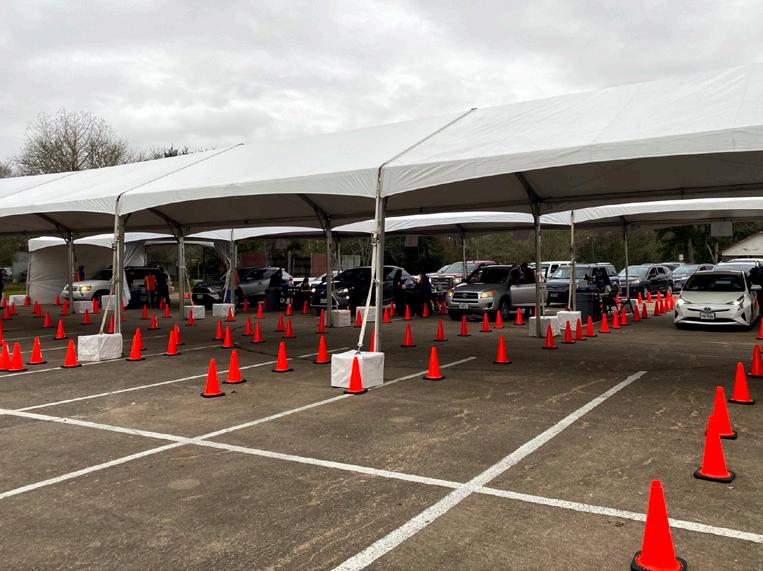



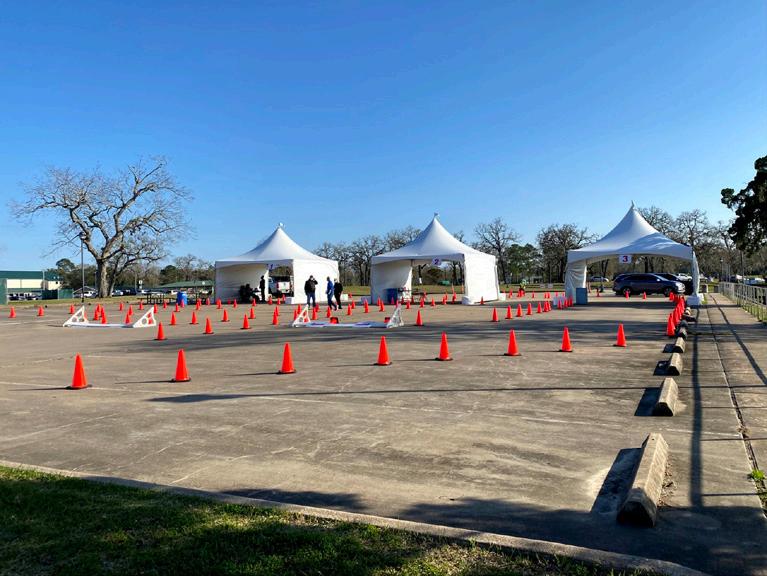 COVID-19 mass vaccination site setup to ensure safe vehicular travel
UTMB and GCHD clinical staff provide COVID-19 vaccines
Members of the public line up in Lake Jackson for COVID-19 vaccines
People waiting after receiving their COVID-19 vaccines in Lake Jackson
EHS provided support to ensure mass vaccination sites were safe for workers and the public, and compliant with medical waste regulations
UTMB and GCHD clinical Staff provide COVID-19 vaccines in League City
In-vehicle COVID-19 vaccinations provided at Walter Hall Park in League City
COVID-19 mass vaccination site setup to ensure safe vehicular travel
UTMB and GCHD clinical staff provide COVID-19 vaccines
Members of the public line up in Lake Jackson for COVID-19 vaccines
People waiting after receiving their COVID-19 vaccines in Lake Jackson
EHS provided support to ensure mass vaccination sites were safe for workers and the public, and compliant with medical waste regulations
UTMB and GCHD clinical Staff provide COVID-19 vaccines in League City
In-vehicle COVID-19 vaccinations provided at Walter Hall Park in League City

Regulatory authority for medical waste management at Healthcare facilities is referenced under the Texas Health and Safety Code Chapter 361 and 30 Texas Administrative Code Chapter 326 which covers activities such as storage, collection, handling, transportation, and processing. The State of Texas has issued UTMB a Municipal Solid Waste Permit for the purpose of processing and disposing of medical waste generated at all UTMB facilities include the final processing of an industrial autoclave and medical waste incinerator located on the Galveston campus. The medical waste operations support the University’s adherence to Joint Commission on Accreditation of Healthcare Organizations, National Emerging Special Pathogen Training and Education Center, Centers for Disease Control and Prevention, National Institutes of Health, and federal, state, local, and university requirements.
UTMB’s medical waste operations are relied upon by healthcare, research in support of highcontainment laboratory facility to support infectious disease research, and a resource to the State of Texas in an emergency or biosecurity event. EHS works jointly with BOF Utilities and Property Services to develop medical waste metrics dashboard and align service level monitoring and reporting.
The EPM team worked jointly with Healthcare Epidemiology to launch the lab lid/ dolly system concept to be used in the soiled utility areas to achieve cleanliness standards, plus provide a consistent medical waste collection process throughout the four UTMB campuses and clinics. The system is compliant with the TJC standard and ensures proper storage and prompt disposal of medical waste.

EPM has a recent purchasing agreement to continue offering the lab lid/dolly units to hospital and clinical locations.


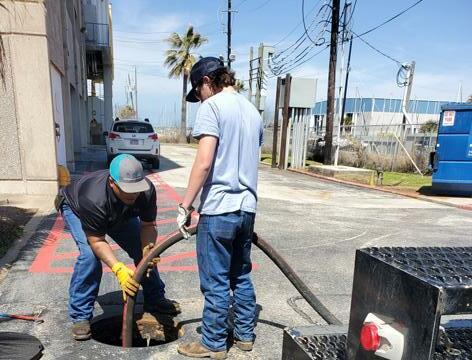
Environmental Protection Management managed a large scale project to clean and refill acid pits across the Galveston Campus. The pits were put into place to ensure no corrosive materials leave the campus and travel to the city water works. The historical tanks were previously cleaned around the time of Hurricane Ike (2008). The pits are required through city ordinances with the City of Galveston. During this project, the pits were emptied out, cleaned, and refilled with new limestone. EPM worked along side contractors, Facilities personnel, and the City of Galveston to ensure that the tanks are in proper compliance for the future.
EPM, BOF Property Services, and Utilities personnel worked together to assist each other with regulatory-required water sampling activities and when special medical waste handling issues arise. We have developed strong working relationships with these groups, resulting in improved customer service and better overall outcomes.


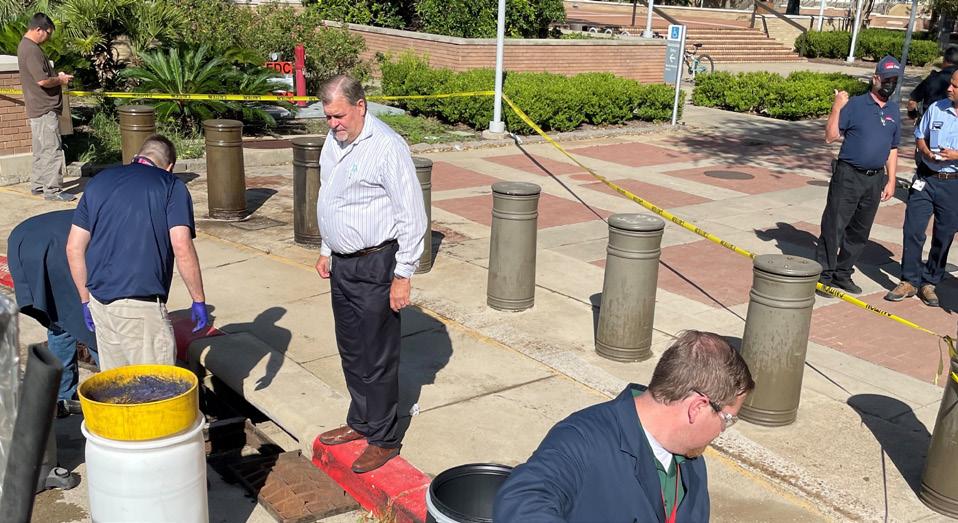

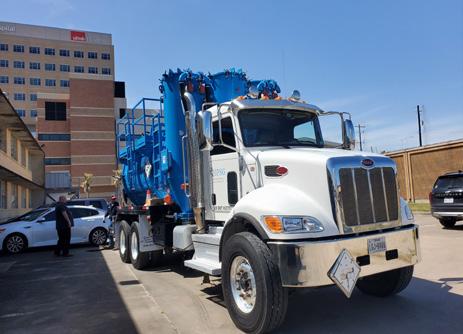 Mike Scott, Dean Leathers, Eddie Stanaland, and Michael Shulke
Rolando Del Cid and Oscar Del Cid (Property Services - Incinerator Service Center) with Eddie Stanaland, EHS Consultant
John Jorgenson Operations Manager, Utilities
Mike Scott, Dean Leathers, Eddie Stanaland, and Michael Shulke
Rolando Del Cid and Oscar Del Cid (Property Services - Incinerator Service Center) with Eddie Stanaland, EHS Consultant
John Jorgenson Operations Manager, Utilities


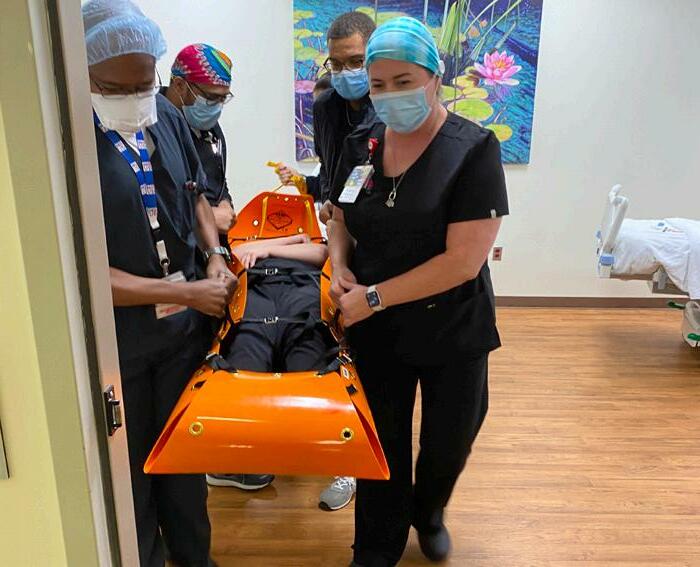



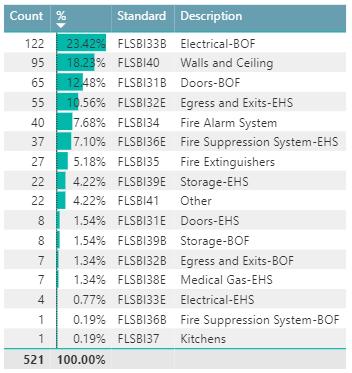




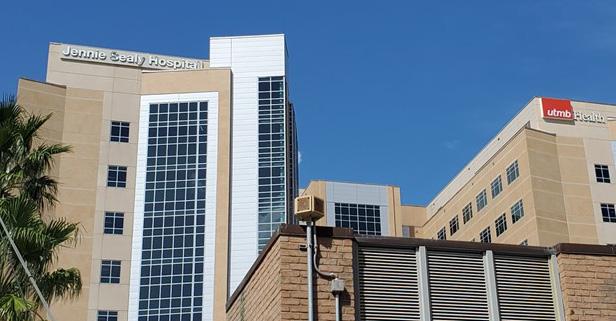
What may seem like an easy task, putting all our Joint Commission documents into a single, accessible library, actually is no simple feat. The team had to step into the shoes of a Joint Commission surveyor and build the system from their perspective of having no experience with UTMB. And, then wade through 7 committees worth of material over 3 years. Life Safety, alone has more than 2,000 records carefully reviewed for accuracy and custom cataloged according to The Joint Commission’s Elements of Performance – the measure by which we are graded.



Small speakers – big sound. While innocuous and small, these speakers that blend into the background have large, high quality sound indoors and out. Fire and Life Safety has completed a significant milestone with the enhancement of our communications abilities by installing outdoor speakers in various areas around campus. These are tied into our alarm network in order to inform visitors, employees and patients about the status of a given event. For example, if you have evacuated due to a fire alarm we will be able to give everyone a clear “AllClear” message sooner. These also will enhance our ability to respond to other events such as Dr. Pink, Active shooter, etc. You should hear the system being tested quarterly.


EHS has and continues to work closely with Supply Chain and Infection Control & Healthcare Epidemiology to evaluate alternative PPE options whenever our standard products are not available. In FY21, EHS evaluated several different types of alternative N95 respirators to ensure adequate numbers and types of N95 are available to support our health care workers. Gloves also became a challenge to get, with several new manufacturers entering the market to try and sell their brands of gloves. EHS was provided samples of several glove options and evaluated them for suitability for use within health care as well as within research. Much to our surprise, many of the gloves tested from these new manufacturers were of such poor quality that failed catastrophically upon donning, or developed tiny holes through which fluids could pass easily. This proactive evaluation of PPE helped to ensure our employees and students had only the highest quality of PPE available.
One example of a glove evaluated by EHS that failed catastrophically upon donning


 EHS testing of proposed glove options identified quality control issues such as tiny holes
Some gloves evaluated by EHS presented serious quality control issues including holes upon removal from the box
EHS testing of proposed glove options identified quality control issues such as tiny holes
Some gloves evaluated by EHS presented serious quality control issues including holes upon removal from the box
Safety Technician

Safety Program
years of service
Billy McBride


Sr. Safety Technician

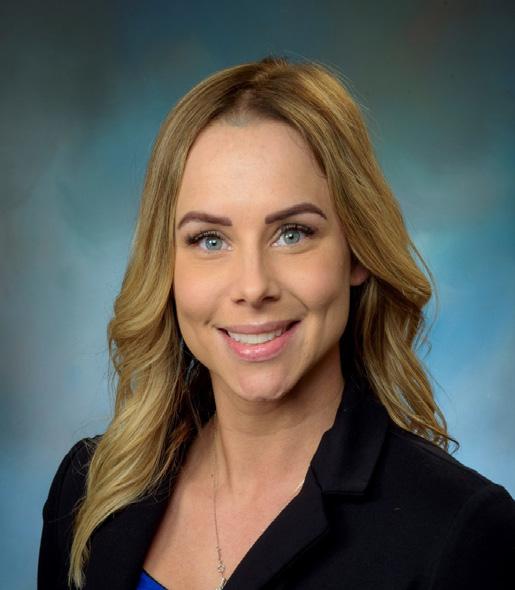

Fire & Life Safety Program
years of service
Alfio Tropea Safety Specialist
& Life Safety Program
years of service

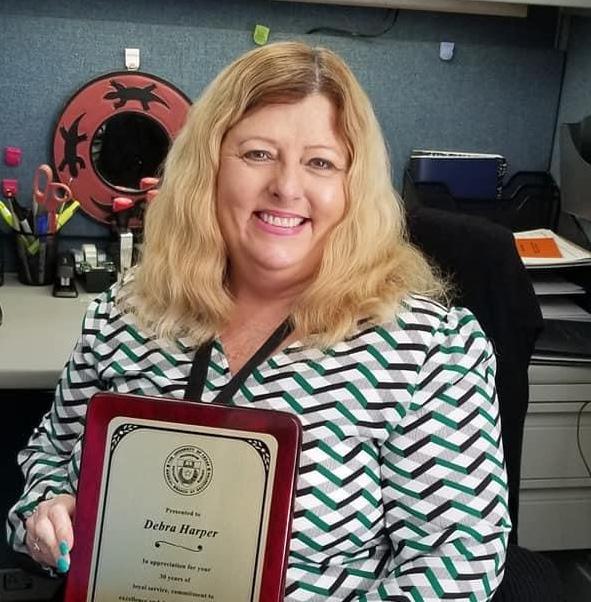







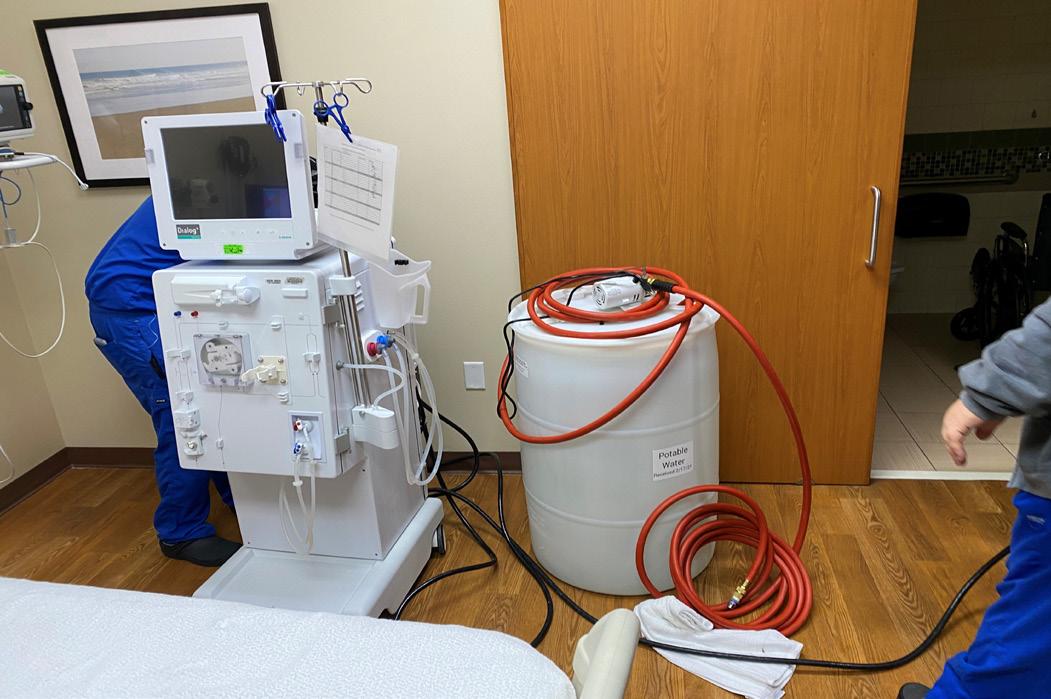
 Seawall Boulevard view of the snow and beach
Seawall Boulevard and beach
Clinical Equipment Services, dialysis clinicians, and EHS worked together to create this, off-the-shelf method, to provide emergency dialysis
Blown valve in garage 3
CSW sprinkler repairs
6” valve cracked
Blown valve in Garage 3
Cracked fitting in Garage 3
Brandon Metting, Safety Specialist, making repairs in garage 4
Seawall Boulevard view of the snow and beach
Seawall Boulevard and beach
Clinical Equipment Services, dialysis clinicians, and EHS worked together to create this, off-the-shelf method, to provide emergency dialysis
Blown valve in garage 3
CSW sprinkler repairs
6” valve cracked
Blown valve in Garage 3
Cracked fitting in Garage 3
Brandon Metting, Safety Specialist, making repairs in garage 4

